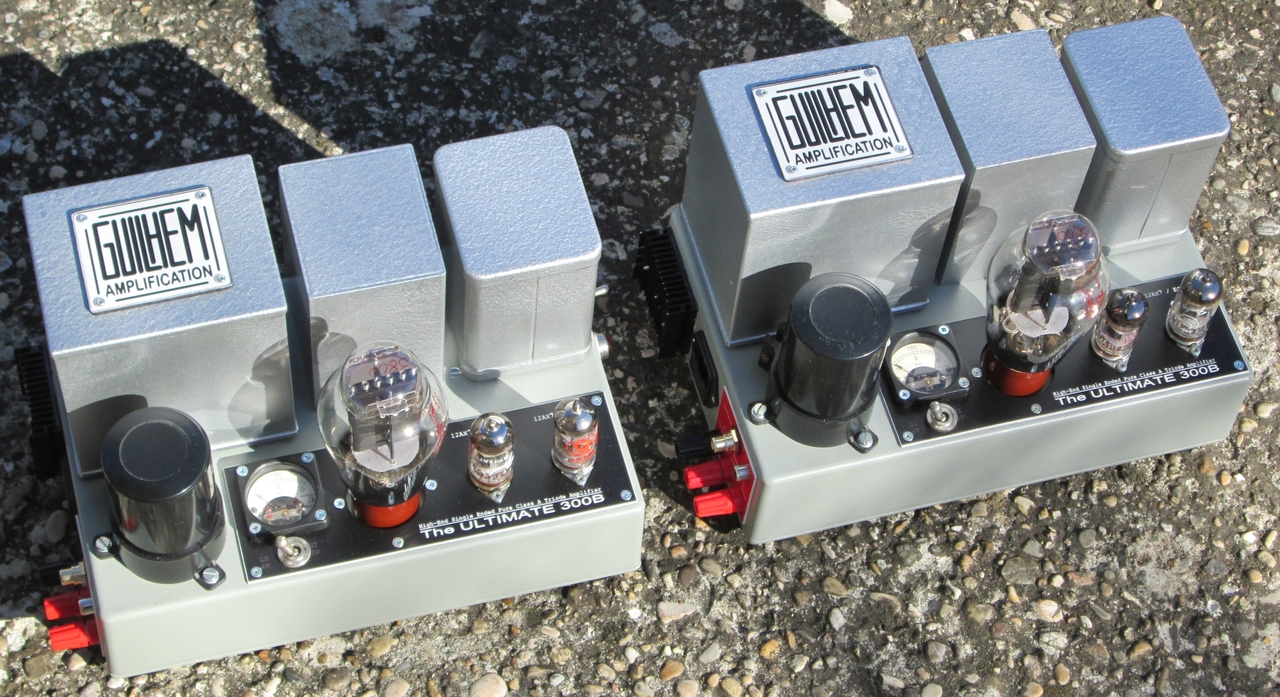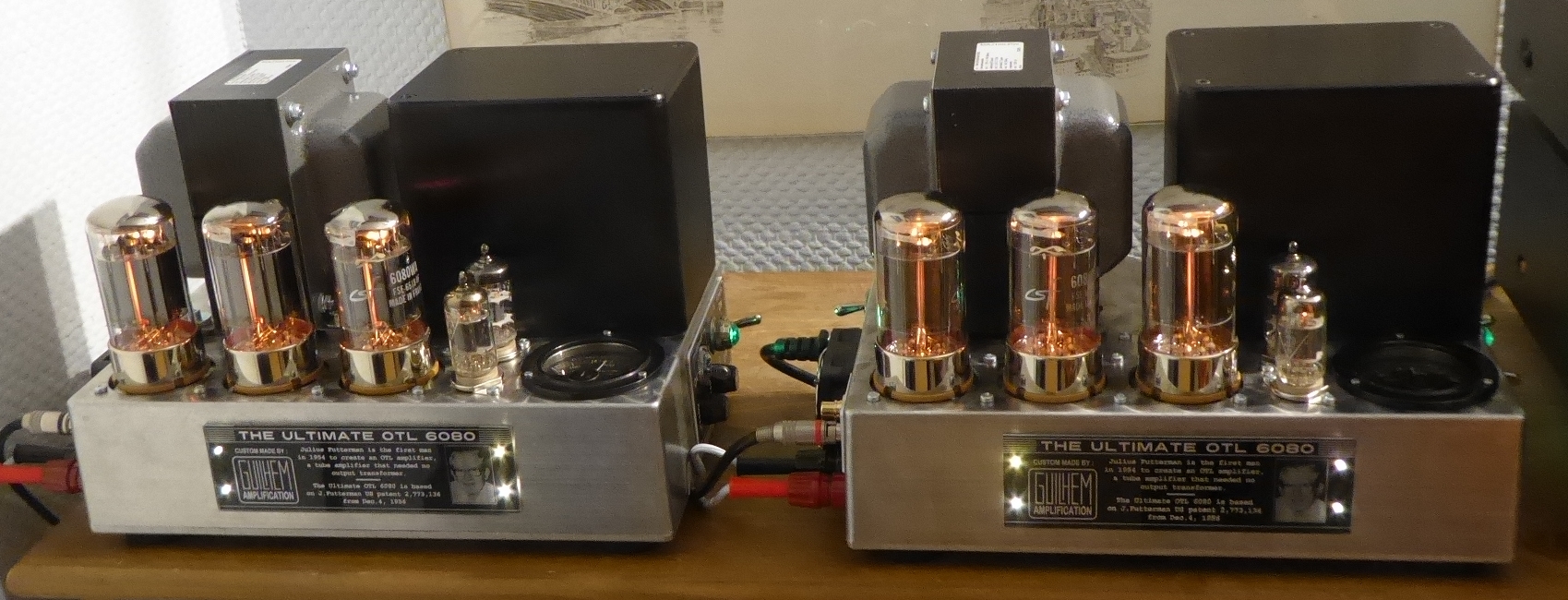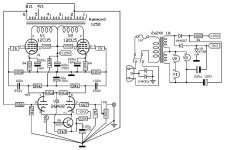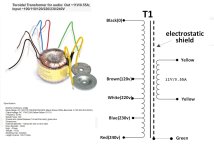Here’s another mini amp I have. The endbells on the OPTs are plastic jelly tubs from Denny’s restaurant.

Usable for a couple of watts. 1,5W before clipping if I recall correctly. I had to reduce the feedback because it was unstable with these OPTs -never tried with Hammond or better. All in all, not a very linear amp but very wide response. It sounds very pleasing with sensitive speakers.I see - thanks @MagicBus ! Reading the 12CU5 specs, you probably reach in PP at least 1WRMS undistorted in PP...😎
View attachment 1202305
T
Here’s another mini amp I have. The endbells on the OPTs are plastic jelly tubs from Denny’s restaurant. View attachment 1202309
PS, it’s a Magnavox 8601 made fancy.
Here’s another mini amp I have. The endbells on the OPTs are plastic jelly tubs from Denny’s restaurant. View attachment 1202309
This makes me think about those 50s US bicolor cars... 😎 😎 😎
Or their pale French imitations (SIMCA Ariane) :
@djn : did you designed/built this amp chassis ?
Usable for a couple of watts. 1,5W before clipping if I recall correctly. I had to reduce the feedback because it was unstable with these OPTs -never tried with Hammond or better. All in all, not a very linear amp but very wide response. It sounds very pleasing with sensitive speakers.
I see @MagicBus - so you used these power toroids (below) as output transformers :
I guess that these are not really designed for that use, but why not ? "Interesting misuse", if I can say so ! 😉
So you have one power tube plate connected to Blk 0, the other plate connected to Red 240V, and you use the Brown 120V tap as the CT of the primary to go to B+, right ?
If so, did you checked the symetry of that primary ? I mean : I wonder if the characteristics (DCR, L) of those "half-primaries" are the same - or are well balanced, in other words. 🤔
T
Off-topic, but my parents had one of those Simca's; but unfortunately not a two-tone. People in the neighborhood thought we were weird.
No. Late one night I was it on eBay for a good price and I bought it. I use it one my desk and there is enough power for close listening.
😳Off-topic, but my parents had one of those Simca's; but unfortunately not a two-tone. People in the neighborhood thought we were weird.
Really not common in the USA
You are right! Just another way for a fun project. It seems that symmetry is an easy thing for toroids. I didn't check for inductance, only turns ratio and DCR. I did remove some turns from the secondary to adjust the 4k2:8 ohm ratio but on second thought it might not be necessary as it would be just a bit off. One question is if the core material is optimized for audio but then the transformer is well oversized for this tiny amp.This makes me think about those 50s US bicolor cars... 😎 😎 😎
View attachment 1202390
Or their pale French imitations (SIMCA Ariane) :
View attachment 1202393
@djn : did you designed/built this amp chassis ?
I see @MagicBus - so you used these power toroids (below) as output transformers :
View attachment 1202392
I guess that these are not really designed for that use, but why not ? "Interesting misuse", if I can say so ! 😉
So you have one power tube plate connected to Blk 0, the other plate connected to Red 240V, and you use the Brown 120V tap as the CT of the primary to go to B+, right ?
If so, did you checked the symetry of that primary ? I mean : I wonder if the characteristics (DCR, L) of those "half-primaries" are the same - or are well balanced, in other words. 🤔
T
Additional pictures taken outside :
Glossy Plexi back-engraved front face...

But printed-plasticized rear face :


I still have his brother in its original look (late 80s - early 90s) :


To revamp this later one, I'd like a more performant circuit, including tone-correctors, in a kit form but still in a very compact size to enter this little box... Well, it may not be easy to find ! 😕
Any clues ? Thanks ! 😉
T
Glossy Plexi back-engraved front face...
But printed-plasticized rear face :
I still have his brother in its original look (late 80s - early 90s) :
To revamp this later one, I'd like a more performant circuit, including tone-correctors, in a kit form but still in a very compact size to enter this little box... Well, it may not be easy to find ! 😕
Any clues ? Thanks ! 😉
T
Hello gentlemen,
I have been following this thread for several days and find these mini-size audio components fascinating. I know nothing about tubes but have constructed several solid state diy projects with success.
Are these amps useful from a practical standpoint? For example could some of them power a pair of bookshelf speakers to fill a smaller room?
Regardless, I really enjoy seeing the pictures and the obvious level of craftsmanship and detail put into them. Are there any "mini" projects available for sale from suppliers on the web? Keep up the great work!
Dave M.
I have been following this thread for several days and find these mini-size audio components fascinating. I know nothing about tubes but have constructed several solid state diy projects with success.
Are these amps useful from a practical standpoint? For example could some of them power a pair of bookshelf speakers to fill a smaller room?
Regardless, I really enjoy seeing the pictures and the obvious level of craftsmanship and detail put into them. Are there any "mini" projects available for sale from suppliers on the web? Keep up the great work!
Dave M.
Hello gentlemen,
I have been following this thread for several days and find these mini-size audio components fascinating. I know nothing about tubes but have constructed several solid state diy projects with success.
Are these amps useful from a practical standpoint? For example could some of them power a pair of bookshelf speakers to fill a smaller room?
Regardless, I really enjoy seeing the pictures and the obvious level of craftsmanship and detail put into them. Are there any "mini" projects available for sale from suppliers on the web? Keep up the great work!
Dave M.
Thanks @UncleMud ! 🙂
The MICRO-AMP and The MICRO-PREAMP were sleeping ideas for dozen years... It was a challenge to prove that Tubes don't imply big, heavy and complicated circuits and releases.
Yes, I could have built The matching MICRO-PREAMP with tubes, and I should try to see if it is doable in the other "Le Micro" brother.
Indeed, with its mere 2x 1WRMS, the MICRO-AMP is completely able to drive Bookshelf speakers. Below it is hooked to my pair of The CUBE Bookshelf speakers (only 200x200x200mm) which are 88dB/W/m efficiency. It's way loud enough for a comfortable everyday listening.
Is there such small projects available from web suppliers ? Possibly - at least for headphones driving. But they will not have that Retro-Cool presentation, and - I guess - be offered in a bit larger size also ! 😉
T
Thank you for elaborating on your projects. I appreciate that.
I hope you continue to get many hours of listening from your Micro-amp. That looks like a nice set-up. I keep hearing on these forums that high wattage is not necessarily a requirement for enjoyable listening. Your Micro-amp seems to validate that train of thought.
I am currently building a 150W Class AB amp (mainly due to the fact that I had the transformer and enclosure lying around and wanted to make use of them). However, I am really interested in building what I used to hear called a "bookshelf system" suitable for an apartment. This is, in part, why I have found this thread so intriguing.
It's obvious that much of your work is hand-crafted. I wouldn't have that level of skill but do enjoy seeing other builders' examples of such. Cheers!
I hope you continue to get many hours of listening from your Micro-amp. That looks like a nice set-up. I keep hearing on these forums that high wattage is not necessarily a requirement for enjoyable listening. Your Micro-amp seems to validate that train of thought.
I am currently building a 150W Class AB amp (mainly due to the fact that I had the transformer and enclosure lying around and wanted to make use of them). However, I am really interested in building what I used to hear called a "bookshelf system" suitable for an apartment. This is, in part, why I have found this thread so intriguing.
It's obvious that much of your work is hand-crafted. I wouldn't have that level of skill but do enjoy seeing other builders' examples of such. Cheers!
Thanks again @UncleMud ! 🙂
Conversely to you, I know nearly nothing about designing and building Solid-State amps and preamps... 😕 I am thinking about venturing in the SS amp world with a JLH69 2x10W Class A kit, re-using - like you ! - leftover parts...
And yes, for a Bookshelf System, you don't need huge watts of power... A single-ended tube amp offering 3 to 5WRMs is way enough (think that my MICRO-AMP is only 1WRMS and is already fine).
My U-300B is a 4WRMS (Lo/Eco mode) and 8WRMS (Hi mode) :

My U-OTL is a 10WRMS :

My U-6V6 (flanking The MICRO-AMP) will be 2WRMS :

My U-KT120 will be a 10WRMS amp set :

Nothing powerful here... But way enough to play too loud ! 😉
T
Conversely to you, I know nearly nothing about designing and building Solid-State amps and preamps... 😕 I am thinking about venturing in the SS amp world with a JLH69 2x10W Class A kit, re-using - like you ! - leftover parts...
And yes, for a Bookshelf System, you don't need huge watts of power... A single-ended tube amp offering 3 to 5WRMs is way enough (think that my MICRO-AMP is only 1WRMS and is already fine).
My U-300B is a 4WRMS (Lo/Eco mode) and 8WRMS (Hi mode) :

My U-OTL is a 10WRMS :

My U-6V6 (flanking The MICRO-AMP) will be 2WRMS :

My U-KT120 will be a 10WRMS amp set :

Nothing powerful here... But way enough to play too loud ! 😉
T
After modifications of the RIAA network, the MICRO-PREAMP follows the RIAA spec from 20Hz to 1kHz at +/-0.5dB and from 1kHz to 20kHz at +/-1dB.


BLACK = RIAA specification
BLUE = L channel RIAA measurements
RED = R channel RIAA measurements
GREEN = deviation from RIAA spec
extreme left columns = L channel RIAA measurements of the stock 42-2109 circuit.
Not so bad for such a simple 2-transistor economical circuit...

T
BLACK = RIAA specification
BLUE = L channel RIAA measurements
RED = R channel RIAA measurements
GREEN = deviation from RIAA spec
extreme left columns = L channel RIAA measurements of the stock 42-2109 circuit.
Not so bad for such a simple 2-transistor economical circuit...
T
Getting the RIAA right is a matter of the correct feedback values, taking into account the finite loop gain of the amplifier they’re wrapped around. Usually needs a step beyond just plugging into a calculator. Hence the popularity of those passive networks touted by “audiophiles” - because those come out closer without having to make corrections. So does using a wide GBW op amp, but that’s what we’re trying to avoid using.
Ive found these little 2 transistor circuits which run on high voltages to sound rather nice, having more signal headroom and better slew rate than many cheap op amps that came in these “adapters” back in the day. One has a 1458 op amp in it, and sounded like the stylus mistracking on vocals with a lot of sibilance. Swapping with a 5532 sounded cleaner, but I still liked the sound of the discrete ones that Radio Shack put in their cheap DJ mixers at the time. I copied and used it on more than one occasion. Aside from using 2SC458 transistors of course. Damn near every one of them went bad and sounded like popcorn/thunder. Did the type in yours ever give you any trouble?
Ive found these little 2 transistor circuits which run on high voltages to sound rather nice, having more signal headroom and better slew rate than many cheap op amps that came in these “adapters” back in the day. One has a 1458 op amp in it, and sounded like the stylus mistracking on vocals with a lot of sibilance. Swapping with a 5532 sounded cleaner, but I still liked the sound of the discrete ones that Radio Shack put in their cheap DJ mixers at the time. I copied and used it on more than one occasion. Aside from using 2SC458 transistors of course. Damn near every one of them went bad and sounded like popcorn/thunder. Did the type in yours ever give you any trouble?
Getting the RIAA right is a matter of the correct feedback values, taking into account the finite loop gain of the amplifier they’re wrapped around. Usually needs a step beyond just plugging into a calculator. Hence the popularity of those passive networks touted by “audiophiles” - because those come out closer without having to make corrections. So does using a wide GBW op amp, but that’s what we’re trying to avoid using.
Yes - that's probably why I did not found proper "real life" FB calculation method for RIAA networks, but a load for passive ones... 😉
That said, it's thank to the help of a member from another forum that I could optimize the RIAA network of my MICRO-AMP. Perhaps he could set up his SPICE simulator quite close to reality, because at least in the bass RIAA section, his predicted curve results proved to be exact, after mod checking.
Ive found these little 2 transistor circuits which run on high voltages to sound rather nice, having more signal headroom and better slew rate than many cheap op amps that came in these “adapters” back in the day. One has a 1458 op amp in it, and sounded like the stylus mistracking on vocals with a lot of sibilance. Swapping with a 5532 sounded cleaner, but I still liked the sound of the discrete ones that Radio Shack put in their cheap DJ mixers at the time. I copied and used it on more than one occasion. Aside from using 2SC458 transistors of course. Damn near every one of them went bad and sounded like popcorn/thunder. Did the type in yours ever give you any trouble?
Many cheap OP amps Phono preamps... And not so cheap ones ! 😉
My McIntosh MC712 preamp has a pair of NE5534AN for its phono section...
So has my McIntosh "Big" MA6800 integrated amplifier (I wrote "Big" because of its autoformers and 30kg weight) - it is possibly the same circuit as the C712, by the look :
While conversely, my (dead cheap in comparison) NAD 114 preamp offers a discrete phono section :
High-End Quality we said ? Cherchez l'erreur... 😒😆
Yes, that's true : those little 2-transistors circuits are as simple as good sounding - once optimised a bit. Now I'll have to compare it to my two tube references :
My little MICRO-PREAMP, derived from the Reaslistic 42-2109, uses its stock 2SC1740 transistors, not the 2SC458 you mention (possibly on the 42-2101 previous model ?).
For the moment, not trouble with these, but I know that some owners replaced them with 2N5088 transistors, though.
T
- Home
- Amplifiers
- Tubes / Valves
- The Micro-amp

